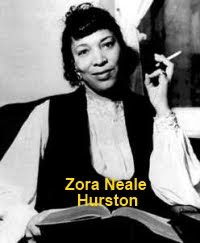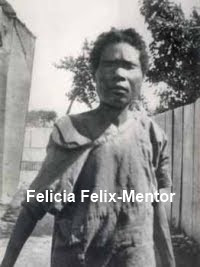During the past few days, I have been involved with a case that had me initially flustered. There has been intensive discussion with the client, genealogy research and several remote perception sessions. As a result, I've determined that Bahamian Obeah sorcery is responsible for the disturbing activity experienced by my client. Though Obeah is not related to Louisiana Voodoo, Haitian Voudo, Hoodoo folk magic or West African Vodun, I am aware of parts of each practice being used in this particular situation. A few years ago, with the fascination of 'zombie culture' starting to go mainstream, I posted the following information:
Zora Neale Hurston was a fascinating woman. In the late 1920s and through the 1930s, she traveled throughout the Caribbean studying various aspects of their culture and society.
 Part of that study included the study of voodoo and of zombies. One story includes a woman named Felicia Felix-Mentor of Haiti. She died of a sudden illness in 1907. But, she was found walking the streets in 1936. Zora Neale Hurston photographed her and interviewed her. The photograph appeared in Life magazine and introduced the American public to zombies.
Part of that study included the study of voodoo and of zombies. One story includes a woman named Felicia Felix-Mentor of Haiti. She died of a sudden illness in 1907. But, she was found walking the streets in 1936. Zora Neale Hurston photographed her and interviewed her. The photograph appeared in Life magazine and introduced the American public to zombies.Hurston’s interview with Felix-Mentor is included in her book Tell My Horse: Voodoo and Life in Haiti and Jamaica (P.S.)
Here is a fascinating interview with Zora Neale Hurston on YouTube. The interview was recorded from the Mary Margaret McBride show on January 25, 1943.
In the interview, Hurston says that she believes that voodoo zombies were never dead. Instead, she says that people are buried alive after being put in some type of drug-induced state of suspended anmiation. They are buried in crypts (not underground) are not embalmed – these are common practices in the Carribean. They are then “reanimated,” sometimes with their bodies intact but missing their minds. - zombietheology.com
-----
 Early in the morning of 24 October, 1936, in the village of Ennery located in the foothills of the Puylboreau mountains near Cap-Haitien, the entire population was aroused into a tumultuous and frenzied consternation when a woman appeared in the streets clad in ragged clothes. She was old, feeble, and stupefied. Her skin was pale and wrinkled and looked like the scales of a fish.
Early in the morning of 24 October, 1936, in the village of Ennery located in the foothills of the Puylboreau mountains near Cap-Haitien, the entire population was aroused into a tumultuous and frenzied consternation when a woman appeared in the streets clad in ragged clothes. She was old, feeble, and stupefied. Her skin was pale and wrinkled and looked like the scales of a fish.From all appearances, she had been suffering from eye disease for a long time. Her eye-lashes had almost fallen out;. she could not bear the glare of sunlight and, to protect her eyes, she had covered her face with a dark dirty rag. This added to the curiosity and superstitious awe of the people.
A mass hysteria swept through the entire village. Crowds gathered around to see that strange woman. People began to ask questions, to cast suspicions, and to try to identify her with various people who were known to be dead long ago.
One of the families living near Ennery, known as the Mentors, noticed that she bore a close resemblance to one of their members. From that day onward people began to call the strange woman by the name of Felicia Felix Mentor. The Mentors took her to their family home, fed her, and gave her comfortable quarters.
She remained in the Mentor's home for a few days until the people removed her to a government hospital. She was in the hospital when, a few weeks after, I was sent from the Public Health Department to make an official study of the strange case which by that time was known all over Haiti.
Felicia Felix Mentor, the alleged Zombi under discussion, was not able to give me any information about her name, her age, her birthplace, where she had been previously, where she was going, and how she happened to be in the hospital. All her answers were unintelligible and irrelevant.
Her occasional outbursts of laughter were devoid of emotion, and very frequently she spoke of herself in either the first or the third person without any sense of discrimination. She had lost all sense of time and was quite indifferent to the world of things around her.
Her height was 5 feet 2 inches, and she weighed 90 pounds. She looked like a woman about 60 years old; but after being treated in the asylum for some time under my care, she rejuvenated and looked like a woman of 50.
The evidence which induced the Mentors at first to believe that the strange woman was the member of their family who died long ago became untenable in the light of a scientific study of the case.
At first they had based their belief on the fact that the woman was lame. Before the real Felicia Felix Mentor died, she was lame as a result of a fracture of her left leg.
Her physical appearance and lameness in addition to the deep belief in the country that sometimes the dead come back to life, induced the Mentors to believe that the strange woman was indeed their late sister Felicia.
I made an X-ray examination of both legs at the Central Hospital in Port-au-Prince. There was no evidence of a fracture and the lameness could therefore be attributed to muscular weakness due to undernourishment. This may be said to be the cause since, after she had a normal diet for two months, the lameness disappeared. She also gained weight.
This is evidently a case of schizophrenia and gives us an idea of how cases of similar nature are likely to arouse mass hysteria in a culture where the common people do not usually understand the scientific basis of many natural events which occur in their daily, life.
The case under discussion was reported by Miss Zora Neale Hurston in her book Tell My Horse, in which she stated emphatically 'I know that there are Zombis in Haiti. People have been called back. from the dead.' This American writer stated specifically that she came back from Haiti with no doubt in regard to popular belief of the Zombi pseudo-science.
In her book, the author described the Felicia Felix Mentor incident as a typical case of a Zombi. Evidently she got her information from the simple village folk, whose minds were conditioned to believing the real existence of a superhuman phenomenon. Miss Hurston herself, unfortunately, did not go beyond the mass hysteria to verify her information, nor in any way attempt to make a scientific explanation of the case.
Evidences from European and other cultures could be found, where whole communities have been aroused into a mass hysteria as a result of the unexpected appearance of queer persons. Such appearances very often rekindled the dying embers of archaic super-stitious beliefs that were deeply rooted in the traditional culture of a people.
Perhaps extension of the province of psychiatry from a study of the individual to a study of the collective behaviour of man may yet reveal to us some of the basic principles underlying the social problems of our time. Certainly, social psychiatry stands a good chance of exploding the Zombi-psychology of the untutored Haitian peasant, as well as any similar beliefs entertained in other cultures. - Louis P. Mars, M.D. - Man: A Record of Anthropological Science - Vol. XLV, no. 22. pp. 38-40 - March-April, 1945
Zora Neale Hurston : Folklore, Memoirs, and Other Writings : Mules and Men, Tell My Horse, Dust Tracks on a Road, Selected Articles (The Library of America, 75)
Tell My Horse: Voodoo and Life in Haiti and Jamaica (P.S.)
Passage of Darkness: The Ethnobiology of the Haitian Zombie

